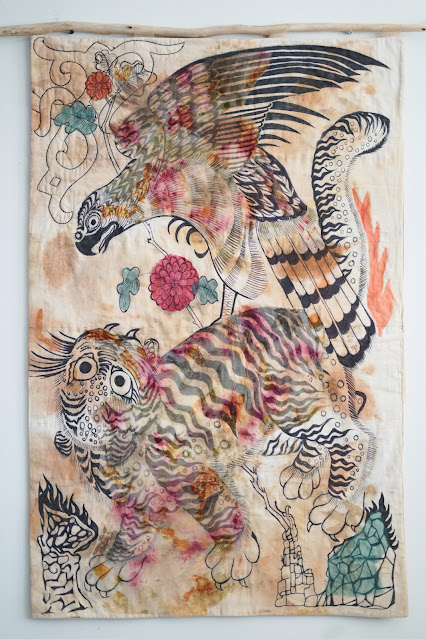Click here to watch the video documenting the project
Prayer Cocoon, installation views at Voelker Orth Museum, New York
 |
| video still from performance titled "Prayer Cocoon" |
Performance on Sunday June 25th at 6pm.
New works on view June 25 through August 27
at the Voelker Orth Museum
The Voelker Orth Museum presents “Prayer Cocoon: PPE in the New Era”, a performance and an exhibition of recent works created by New York based artist Dani Changah Song.
In the performance "Prayer Cocoon," artist Dani Song metaphorically embodies the process of rebirth through the act of sewing. Encasing herself in a loose bodysuit, she establishes a direct correlation to entering a hibernating state within a cocoon. Through this, Song envisions the Prayer Cocoon as a new type of Personal Protective Equipment (PPE) for a post-pandemic world.
Sewing, a fundamental labor associated with sheltering and nesting, symbolizes the primal act of constructing a safe haven. While architectural dwellings provide stable and stationary shelter, textiles have historically served as materials for nomadic shelters and protective coverings. In Song's recent textile artworks and accompanying performance, she delves into the contemporary meaning of "protection and shelter in the post-COVID era.”
Textiles, beyond their utilitarian function, have served as carriers of tradition and cultural narratives. Inspired by Bojagi, Korea's traditional wrapping textile, Song's artworks exude a light and fluid appearance. She refers to them as amulets, portable totems that can be installed in any chosen space by the beholder. Serving as vessels of prayers and yearnings, each artwork bestows a sense of sanctity upon its surroundings. Crafted from silk fabric dyed with organic pigments, the artworks stand as proxy for the natural world. The fabric's transparency allows light to permeate, illuminating the environment in which it is situated. This cumulative effect evokes the ambiance reminiscent of stained glass windows found in houses of worship, filtering light and fostering a personal space for contemplation and meditation.
"Prayer Cocoon" was made possible (in part) with public funds from the Queens Arts Fund, a re-grant program supported by New York City Department of Cultural Affairs in partnership with the City Council and administered by New York Foundation for the Arts.





Leftover natural dye on cotton; 29.5 by 50 inches; 2020
Sewn with the remnants fabric from face covering making activities during pandemic lockdown, the title ”Leftover" denotes the feeling of guilt but it also hints at the resilience in the time of crisis.


Icon I pigment and gold leaf on silk, mounted on paper 20 by 24.5 inches; 2015-2016
The images of Icon I & II were taken directly from the propaganda photographs released by the North Korean government. Exploring the theme "cult of personality" of Kim Jong-un, I tried to reconcile the spectacle of seemingly genuine emotions(expressed by the children depicted in the paintings) with an equally striking fascination expressed by the media. The style of paintings was influenced by the spectacular visual impact of Himalayan Thangka paintings. The delirious reverence expressed both in Thangka and the propaganda stills seemed to trigger something darkly instinctual within the mass. The "otherness" heightened by the media's interpretation, and the exploitation of the human emotions through the images seemed to be a pervasive theme in contemporary cultural landscape.


In the project titled “Currency of the Assimilation”, a commemorative coin was designed to mark my naturalization. Goldsmith was commissioned to fabricate the coins from18 carat gold, in the edition of six. Embossed on the coins are the years I spent as a resident alien, drawing the tongue-in-cheek comparison between the years of assimilation to a monetary value.
Coins are then bartered with artworks done by other artists. The project will be completed when all but one coin is spent on acquiring artworks. The exhibition of these artworks as a collection, including the one remaining commemorative coin will be presented as one complete conceptual project.
Vaguely comical in its megalomaniac virtues, self minted commemorative coins usually are signifiers of power and prestige. But I considered these coins to be the keepsakes of the future - the engraved year on the coin marks the years I resided in the United States as an alien. And at same time, it represented the promise of my future self as a “naturalized” citizen. The benefits and the burden of becoming a citizen is represented through the paradigm of capitalism, where the value of “assimilation”(represented by the coin) is exchanged with the ownership of goods and prestige. The conduit of this narrative is the gold coin, a universally accepted holder of value. In a more profound sense, it may be absurd to think a person can change nationality overnight, yet the “nationality” is a concrete right one can exercise given the right conditions. American values are based on such a notion. The act of minting & spending the coins presents the idea of "legal status" as a kind of currency and a leverage.

















